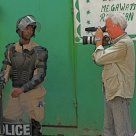WATCH ABOVE: 16×9’s “Deadly Flight”

Michael Mesure remembers every vivid detail of the day he decided to devote his life to the cause of making cities safer for birds.
It was May 16, 1990. The high point of the spring migration season. It was foggy in Toronto’s downtown financial district, and birds were falling out of the sky after colliding with glass-encased towers.
“It’s etched in my brain. A combination of dead and dying. They were dropping all around me.”
Mesure travels with supplies of paper bags to carry wounded birds to safety. But that morning there were so many casualties he quickly ran out, so he scrounged through dumpsters looking for bags that people had thrown away. He filled his car with the rescue bags and drove off, intending to release the injured birds far away from the downtown core.
“I was driving up the Don Valley Parkway and one (of the birds) escaped from a bag . This one flew and perched itself on my rear-view mirror. It started to sing inside my car. I was fixated on this bird for about 10 seconds.” Here, Mesure stops, too choked up to continue. But he soon collects himself. “It dropped dead in my lap. And it struck me ever since. That’s why I’m here. It was trying to tell me something and I just couldn’t ignore it.”
Three years later, Mesure, who owned an art gallery and antique shop, started a non-profit group called FLAP—Fatal Light Awareness Program—and began lobbying the City of Toronto to pass building guidelines that would better protect migrating birds against window strikes.
He also assembled teams of volunteers who patrol the city at dawn, looking for the dead and wounded. Over the years, they have collected 60,000 dead birds, and rescued thousands of the injured. But this is only a tiny fraction of the casualty toll.
Mesure calculates that every year, a million birds die of window strikes in the city. It’s a very rough calculation, based on the fact that there are 940,000 structures in the city, most of them have at least one glass window, and each window has at least one fatal strike per year.
The North American toll of deaths by window strikes has been estimated at between 100 million and one billion a year—a carnage equivalent, at the low end, to 300 Exxon Valdez oil spills per year. (The Exxon Valdez oil spill off the coast of Alaska in 1989 killed roughly 300,000 seabirds, and got worldwide attention.)
Yet most city dwellers are unaware of the window strike problem, because gulls, rodents and other urban scavengers, as well as cats and dogs, very efficiently dispose of the dead and injured birds before we see them.
“They don’t realize that as they sleep in their beds at night, there’s hundreds of thousands of birds streaming over their rooftops,” says Mesure. “When they come to work and learn about this issue, they start to look for these birds. But the bulk of these birds are either eaten by scavengers, or swept up. It’s very hard to get this through to the public.”
The birds are vulnerable because of simple biology. Birds cannot see glass. All they see is what glass reflects—like trees and the sky—and in a city rich in urban foliage, like Toronto, that creates a hazardous landscape. Toronto is also on a major migratory flight-path, so it’s become one of the world’s most dangerous cities for birds.
Ornithologists, like Daniel Klem of Muhlenberg College in Allentown, Pa, have argued for decades that it’s easy to create a more bird-friendly city: all you need is glass markers that birds can see, and avoid. These markers come in the form of small white dots or squares that, from a few feet away, are virtually invisible to the human eye. But they represent a clear warning to birds.
Mesure says the markers would reduce window strikes by 70 per cent.
The main obstacle is cost. Building owners are, for the most part, reluctant to spend the money to retrofit their glass towers, just to keep bird-lovers happy. So in 2010, the City of Toronto passed guidelines that required all new buildings to have bird-safe glass installed to a height of 12 metres—that’s the maximum height of most urban trees which are reflected in the glass.
These and other guidelines don’t apply to existing buildings, but they have nevertheless become a model for other large cities around the world.
Klem credits Toronto, and especially the work of FLAP, as being “the linchpin in getting our attention and education at a level that would stimulate constructive action.”
Like Mesure, Klem is a tireless advocate for bird-friendly windows. He says we’ve created modern cities with an environment that is pleasing to live in but which kills vast numbers of birds. “This is, in my humble view, ethically and morally unacceptable. We’re obligated to stop that.”
It’s a battle Mesure fights every day. But there is resistance. In Toronto, for example, one of the prime bird kill zones is the property around the massive TD Bank towers, owned by Cadillac Fairview. These properties have been declared off-limits to the FLAP volunteers, because the group joined in a court case against the developer.
Cadillac Fairview won the case, and then notified FLAP that the volunteers would only be welcome on the TD Tower sites if they signed a confidentiality agreement about their findings. In other words, FLAP would not be able to make public the numbers of birds they collect on Cadillac Fairview properties. It’s a deal Michael and his volunteers are reluctant to make, since they consider their findings in the public interest.
But the confrontation doesn’t deter him in the least. “What’s happening in my life is inevitable,” he says. “It’s a calling. I feel I’ve been put on this planet to be doing exactly what I’m doing.”
Don’t miss an encore presentation of 16X9 this Saturday at 7pm.












Comments